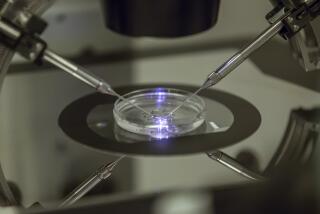Fertility procedure actually cuts birth rate, study finds
- Share via
Pre-implantation genetic diagnosis, widely touted as a way to help older women undergoing in vitro fertilization achieve a higher birth rate, actually reduces births by a third, Dutch researchers reported Wednesday.
The finding represents a major setback for the procedure, which involves removing a single cell from a 3-day-old embryo to look for potential birth defects.
Although only a few thousand procedures are performed each year, researchers estimate the frequency has been growing by as much as 30% a year.
“This is not helping people get pregnant,” said Dr. Elizabeth Ginsburg, medical director of the IVF program at Brigham and Women’s Hospital in Boston, who was not involved in the research. “Smaller studies have shown similar things, but this is a nice, large one.”
The technique remains valid for testing for specific genetic defects that the mother or father are known to carry, which is its most common use.
But “this rings the death knell” for using the technique to routinely screen older women, said Dr. Richard Scott, founder of Reproductive Medicine Associates, a large chain of IVF centers in the Northeast. “Many people in the field already knew that [the technique] is pretty limited,” said Scott, who was not involved in the research.
The technique was developed in the United States about 17 years ago. It is based on the idea that one cell can be removed for analysis from the eight cells in a 3-day-old embryo and that the remaining seven cells will grow into a healthy infant. If genetic analysis shows an abnormality, the embryo is not implanted.
Although it was originally designed to look for specific genetic defects, more recently IVF practitioners have been using it to screen older women having difficulty conceiving in the belief that weeding out embryos with chromosome duplications and other abnormalities would increase the success rate of implantation.
To test this, Dr. Sebastiaan Mastenbroek of the Academic Medical Center in Amsterdam and his colleagues studied 408 women ages 35 to 41. Half were assigned to receive IVF with pre-implantation diagnosis and half just IVF. Each woman went through as many as three IVF cycles.
Mastenbroek reported at a meeting of the European Society of Human Reproduction and Embryology in Lyon, France, that 24% of the women receiving the genetic diagnosis had successful births, compared with 35% of the women who did not undergo the screening. The team does not yet have data on the number of birth defects in the two groups, he said.
The results will be published today in the New England Journal of Medicine.
“Our field has tended to accept new technologies without a lot of scrutiny,” Ginsburg said. “Clearly, this is one that was overrated.”
Researchers do not know why the procedure is lowering the success rate, but they do not think that removing one cell lowers the viability of the embryo.
Scott noted, for example, that the success rate when the technique is used to diagnose known genetic defects is the same as the rate for women undergoing simple IVF.
Several clinical trials underway should shed more light on the problems, he said.
--



